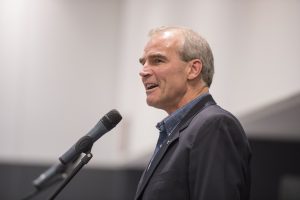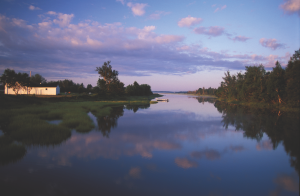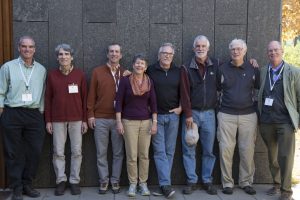“Part of what I love about [QLF] is the way in which [it] has been a thread throughout my whole career; essentially, going back to when I was in high school before I even was thinking about a career,” Phil explains. The themes of conservation and community, which he first encountered through QLF, have remained a focal part of his environmental career over the past thirty years.
QLF Experiences
Living Rivers – Participant, Tabusintac, New Brunswick, 1978
Living Rivers – Instructor, Tabusintac, New Brunswick, 1984
U.S. – U.K. Youth Conservation Exchange, UK and Atlantic Region, 1985 & 1986
International Countryside Stewardship Exchange, Scotland, 1993
QLF Consultant, Vermont, late 1990s-2000s
QLF Alumni Congresses, Hungary 2006 and Catalonia 2016
Council, Quebec-Labrador Foundation

Phil Huffman speaks about his QLF experience at the 2016 Alumni Congress in Barcelona, Catalonia. PHOTOGRAPH BY GREIG CRANNA
“It all began when I was 15, in the summer of 1978,” Phil Huffman recalls. During that summer, Phil embarked on what would become a lasting relationship with the Quebec-Labrador Foundation for decades to come. Phil first heard of QLF when a family friend spoke of her daughter’s experience participating in the Living Rivers Program in 1975 to his mother. “[My mom] floated the idea to me and I thought, ‘Well, yeah that sounds sort of interesting!’ I didn’t really know what I was getting myself into,” Phil jokes. Years later, Phil is now a successful conservationist with several decades under his belt. His career was inspired in part by his initial experience with QLF, which he maintains a fruitful relationship with to this day.
“I’d always had a love of the outdoors, and of critters and fishing and that kind of thing,” says Phil, “[But participating in] the Living Rivers Program is what really opened my eyes to the possibility of a career [in conservation].” He describes his first summer with QLF as “life-changing.” Phil still vividly recalls his journey from southern New England to New Brunswick. Upon landing, he and the other program participants “piled [with their] gear and hundreds of dollars worth of groceries into [Clive Wishart’s] skiff” in the pouring rain, traveling up the Tabusintac River. This is one of the great remaining Atlantic salmon rivers in the world. Phil remembers his weeks there at Living Rivers as an unforgettable introduction to QLF and hands-on conservation.

Wishart’s Point, Tabusintac estuary, New Brunswick, site of QLF’s first environmental education program, Living Rivers (1975). PHOTOGRAPH BY GREIG CRANNA
After Phil’s first summer with QLF in Tabusintac, he returned as an instructor for the Living Rivers Program during the summer of 1984. He had just graduated from Middlebury College with a degree in Environmental Studies, which was a decision that had very much been influenced by his earlier experience at Living Rivers. Returning to instruct for Living Rivers was “a phenomenal experience and a great chance to bring things full circle, having been on the receiving end before,” Phil says. Phil’s relationship with QLF served as a springboard for further opportunities. In 1985, he was invited to participate in QLF’s first U.S. – U.K. Youth Conservation Exchange, along with other Fellows from New England and Canada. He then went on to lead “the reciprocal end of the exchange” in 1986, which consisted of a study tour wherein British Fellows traveled throughout the northeastern U.S. and maritime Canada learning about conservation initiatives. “Those three summers became the platform of a very close relationship with QLF,” Phil recalls.
Phil’s experiences with QLF later presented him with an opportunity for a position with the National Park Service (NPS), focusing on community-based river conservation in the northeastern U.S. His work with NPS served as a “great foundational eight years,” providing him with a real-world education in river conservation through which he built cross-sector partnerships and worked with different stakeholders. While with NPS in the 1980s and 1990s, Phil continued to nurture his relationship with QLF by occasionally stepping in to assist with international exchanges. In 1993, Phil was selected to join a team in the International Countryside Stewardship Exchange Program, which QLF contributed to as a partner organization. Phil traveled to Scotland for ten days as an exchange participant, which he describes as a “phenomenal experience in its own right.”
Phil returned to school in the mid-1990s, receiving dual degrees from Yale University’s School of Forestry and Environmental Studies and School of Management. While at Yale, Phil conducted project-based consulting work with what was then called the NPS Conservation Study Institute (now the Stewardship Institute) and with Marsh-Billings-Rockefeller National Historical Park, which are both active QLF partners based in Woodstock, Vermont. Working closely with former QLF Vice President, Jessica Brown, and current QLF Senior Vice President, Brent Mitchell, Phil carried out a series of consulting projects with the two entities in the ensuing years. Those efforts and relationships became the backbone of what turned into a 10-year stint as a consultant through QLF and independently, with projects in Vermont and elsewhere around the country. As this phase unfolded, the focus of Phil’s work evolved from community-based conservation to large landscape-scale conservation and innovative initiatives like “National Heritage Areas”, a realm that became an ongoing focus for QLF as well..
During these years, Phil obtained his position on the QLF Council, having been invited to join by then QLF President, Larry Morris. “A lot of pieces to this story!” Phil laughs, recalling the different turns that his QLF relationship has taken in the years since he first participated in the Living Rivers Program.
“Part of what I love about [QLF] is the way in which [it] has been a thread throughout my whole career; essentially, going back to when I was in high school before I even was thinking about a career,” Phil explains. The themes of conservation and community, which he first encountered through QLF, have remained a focal part of his environmental career over the past thirty years.

Alumni of Living Rivers Environmental Program, from left to right: Phil Huffman, Michael Caduto, Bob Bolling, Rosemary Furfey, Greig Cranna, Tom Horn, Jim Gaffney, and Larry Morris. PHOTOGRAPH BY GREIG CRANNA
When asked if he has any outstanding memories from his QLF experiences over the years, Phil replies, “I’ve got a flood of them going through my brain as you’re asking the question!” The 2006 Alumni Congress is one event that particularly stands out to him, describing it as “an extraordinary experience to be a part of, […with] a couple hundred people from many different parts of the world.” He continues, “[It was great to see] how their shared connection to the conservation work that they were doing and through the QLF exchanges that they’d been a part of were really helping to break down borders and create new opportunities.” During the Alumni Congress, all participants shared commonalities through their QLF experiences and their shared commitment to conservation and stewardship. Phil also witnessed how it served as “a reflection of the global organization QLF had become at that point […and how it has] only continued to evolve ever since.”
With years of consulting experience under his belt, Phil was offered a position with the Vermont chapter of The Nature Conservancy (TNC) in 2007, leading its conservation team. His role with TNC has evolved over the years since then, but one continuous thread has been on landscape-scale conservation, conserving swaths of forest land that extend across Vermont’s borders to neighboring states and provinces. In this work, Phil and his colleagues focus on “sustaining a connected forested landscape for both people and nature”, much of which involves building partnerships and long-term strategies that encompass a “mix of different conservation” methods from land protection to making roads less of a barrier for wildlife movement. The other big focus of Phil’s work with TNC, which he’s now doing full-time, deals with policy advocacy. In this capacity, Phil works at both the federal and state level to advance TNC conservation priorities through the enactment and implementation of forward-looking conservation policy.
Phil has also served as a volunteer on his town’s Conservation Commission since the early 2000s, including as chair for the last several years. “[This is] my other conservation job; I’m just not getting paid for it,” he laughs, “but that’s okay, because it’s something that I really believe in and it’s important work at a different scale than I’m often working at professionally.”
When Phil reflects on his career thus far, an experience that stands out is “the federal designation of a stretch of the Farmington River in northwestern Connecticut,” which he worked on throughout his time with the NPS in the 1980s and ‘90s. He collaborated with government agencies, nonprofits, and community members to ensure that the Farmington River would be protected with the status of National Wild and Scenic River. The river became “one of the first federally designated rivers in the northeast and [was] one of only a couple at that point that flowed mostly through private lands rather than public lands.” It has since served as a “model that has been replicated” elsewhere.
Phil recognizes QLF’s influence in every aspect of his work. “My QLF experiences are fundamentally a core part of who I am and how I think and work,” he says. Not only has QLF led to many professional opportunities for Phil over the course of his career, but many QLF values have also been intrinsic to his work; in particular, “the mosaic of conservation that [QLF] embraces.” “The strong connection between people and nature, between people and place, that I think are hallmarks of QLF’s work and perspective are very much a part of my career and my outlook as well,” Phil concludes. “[I] just feel very grateful for what… the organization [has] given me over the course of so many years.”
Header Photo: Members of the U.S./U.K. Conservation Exchange during a field trip to Maine, 1986. Left to right: Kerry Lothian Dennis, Diane Hewlett Lowrie, Jessica Brown, Lucy Bonner Kirkham, Sally York Smith, and Phil Huffman. Photograph by Greig Cranna






